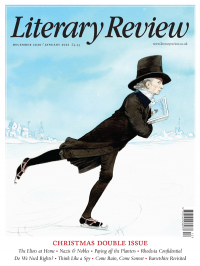Miranda Seymour
He Looked Best in a Skirt
Dangerous to Show: Byron and His Portraits
By Geoffrey Bond & Christine Kenyon Jones
Unicorn 160pp £25
Did Byron ever actually say that he awoke one morning and found himself famous? The poet (as Byron hated to be called, preferring to see himself as a man of action) had been dead for six years when Thomas Moore cited this allegedly authentic declaration – but how did he know? – in a biography perfectly suited to an age that loved a hero and relished a scandal. By 1830, when Moore published that book, the world was mad about Byron. It was his widow, Annabella Milbanke, who concocted the word ‘Byromania’, which best describes the international and still-thriving cult of her wayward husband.
It’s clear that Byron was always obsessed by how he was perceived, not because of his literary ambitions but because the calf and foot of his left leg were deformed. An early painting of him, commissioned by a doting mother and suggesting that she did nothing to reduce her son’s self-consciousness, attempts to obscure the boy’s withered calf behind a strategically placed plant. Mary Shelley, writing in the flyleaf of her copy of Byron’s unfinished verse drama The Deformed Transformed, noted that ‘his personal defect’ influenced everything that he wrote and did.
The pictures in this wonderful book testify to that. Aged eleven, Byron was forced to wear a padded leather boot with a metal sole; by the age of eighteen, he had adopted Beau Brummell’s innovative loose trousers. Posing in 1814 for a celebrated portrait of himself – one over which,

Sign Up to our newsletter
Receive free articles, highlights from the archive, news, details of prizes, and much more.@Lit_Review
Follow Literary Review on Twitter
Twitter Feed
It wasn’t until 1825 that Pepys’s diary became available for the first time. How it was eventually decrypted and published is a story of subterfuge and duplicity.
Kate Loveman tells the tale.
Kate Loveman - Publishing Pepys
Kate Loveman: Publishing Pepys
literaryreview.co.uk
Arthur Christopher Benson was a pillar of the Edwardian establishment. He was supremely well connected. As his newly published diaries reveal, he was also riotously indiscreet.
Piers Brendon compares Benson’s journals to others from the 20th century.
Piers Brendon - Land of Dopes & Tories
Piers Brendon: Land of Dopes & Tories - The Benson Diaries: Selections from the Diary of Arthur Christopher Benson by Eamon Duffy & Ronald Hyam (edd)
literaryreview.co.uk
Of the siblings Gwen and Augustus John, it is Augustus who has commanded most attention from collectors and connoisseurs.
Was he really the finer artist, asks Tanya Harrod, or is it time Gwen emerged from her brother’s shadow?
Tanya Harrod - Cut from the Same Canvas
Tanya Harrod: Cut from the Same Canvas - Artists, Siblings, Visionaries: The Lives and Loves of Gwen and Augustus John by Judith Mackrell
literaryreview.co.uk